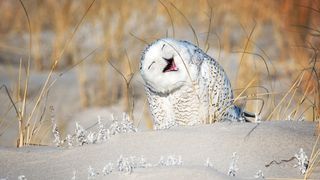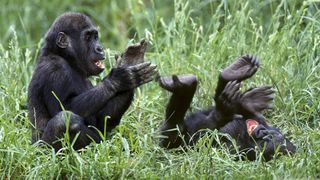
Do animals laugh?
Animal vocalizations made during play are a close analogue to human laughter.

Laughing together is an important way for people to connect and bond. And though the causes of laughter can vary widely across individuals and groups, the sound of a laugh is usually recognizable between people belonging to different cultures.
But what about animals other than humans? Do they "laugh," and do the causes of their laughter resemble the triggers for human laughter? In humans, laughter can express a range of emotions — from positive feelings like enjoyment to negative ones such as disgust. People also laugh when they hear a joke, or when they see something that they think is funny, though it's unknown if animals' intelligence includes what humans would call a sense of humor.
However, many animals produce sounds during play that are unique to that pleasant social interaction; researchers consider such vocalizations to be a close analogue of human laughter. Recently, scientists investigated play vocalization to see how common it was among animals. The team identified 65 species that "laughed" while playing; most were mammals, but a few bird species demonstrated playful laughter too. This new analysis could help scientists to trace the evolutionary origins of human laughter, according to a new study.
Related: Do any animals know their grandparents?
Because some types of play behavior look like fighting, animals may vocalize, or laugh, during play to keep interactions from escalating and becoming aggressive or harmful, the researchers reported April 19 in the journal Bioacoustics. Unlike fighting, play is usually repetitive and happens independently of other social behaviors, such as mating or searching for food, said lead study author Sasha Winkler, a doctoral candidate of biological anthropology at the University of California, Los Angeles.
When it comes to identifying play, "people who study primates say, 'You know it when you see it,'" Winkler told Live Science. One sign is that primates — our closest relatives — have a "play face" that resembles the expressions of humans who are playing, she explained.
When Winkler previously worked with rhesus macaques (Macaca mulatta), she had noticed that the monkeys panted quietly while playing. Many other primates are also known to vocalize during play, she said. Winkler and study co-author Greg Bryant, a professor and vice chair in UCLA's Department of Communication, wondered whether animal laughter might be even more widespread. They reviewed dozens of prior research "looking for any mentions in any animal of vocal signaling during play" like the panting of the macaques, Winkler said.
Sign up for the Live Science daily newsletter now
Get the world’s most fascinating discoveries delivered straight to your inbox.
Their investigation turned up dozens of examples, with reports of vocal play signals "throughout the mammal literature, especially among primates, rodents, social carnivores and (to a lesser extent) marine mammals," the scientists wrote in the study.

Make 'em laugh
Many of these sounds only occurred during play, such as the purr of a vervet monkey (Chlorocebus aethiops), the ultrasonic trill of a rat (Rattus norvegicus), the whistle and squawk of a bottlenose dolphin (Tursiops truncatus) and the peeping of a squirrel monkey (Saimiri sciureus). Most primate species, including chimpanzees, gorillas, monkeys and baboons, demonstrated playful laughter: from panting chuckles, lip-smacking and grunts to cackles, trills and squeals, according to the study.
Though most of the laughing animals were mammals, two bird species — the Australian magpie (Gymnorhina tibicen) and the kea parrot (Nestor notabilis) — also vocalized during play, the researchers reported. In a 2017 study of kea parrots, which live in New Zealand, scientists found that if they recorded keas' warbling laughter and played it through a speaker, other keas "would spontaneously start playing," Winkler said. That study demonstrated how kea laughter acts as an invitation to other keas, "specifically to facilitate and to initiate play," Winkler said.
Reports of playful laughter were notably absent in studies describing fish, amphibians and reptiles, perhaps because there is some question as to whether or not play exists at all in those animal groups, according to the study.
Laughter in humans is thought to have originated during play, a hypothesis supported by the play-related panting laughter of many primate species. Human laughter may have evolved from a similar panting sound that, "over evolutionary time became ritualized into the vocalized 'ha ha ha' that we use today," Winkler said. People still laugh during play, but we also incorporate laughter into language and non-play behaviors, using laughter in diverse ways to convey a range of emotions that may be positive or negative, the researchers reported.
Human laughter notably differs from other animals' laughter in another important way: its volume. People broadcast their laughter loudly, often as a way of establishing inclusion in a group. By comparison, when most animals laugh, the sound is very quiet — just loud enough to be heard by the laugher's partner, according to the study.
"It's really fascinating that so many animals have a similar function of vocalization during play," Winkler told Live Science. "But we do have these unique parts of human laughter that are also an important area for future study."
Originally published on Live Science.

Mindy Weisberger is an editor at Scholastic and a former Live Science channel editor and senior writer. She has reported on general science, covering climate change, paleontology, biology and space. Mindy studied film at Columbia University; prior to Live Science she produced, wrote and directed media for the American Museum of Natural History in New York City. Her videos about dinosaurs, astrophysics, biodiversity and evolution appear in museums and science centers worldwide, earning awards such as the CINE Golden Eagle and the Communicator Award of Excellence. Her writing has also appeared in Scientific American, The Washington Post and How It Works Magazine. Her book "Rise of the Zombie Bugs: The Surprising Science of Parasitic Mind Control" will be published in spring 2025 by Johns Hopkins University Press.